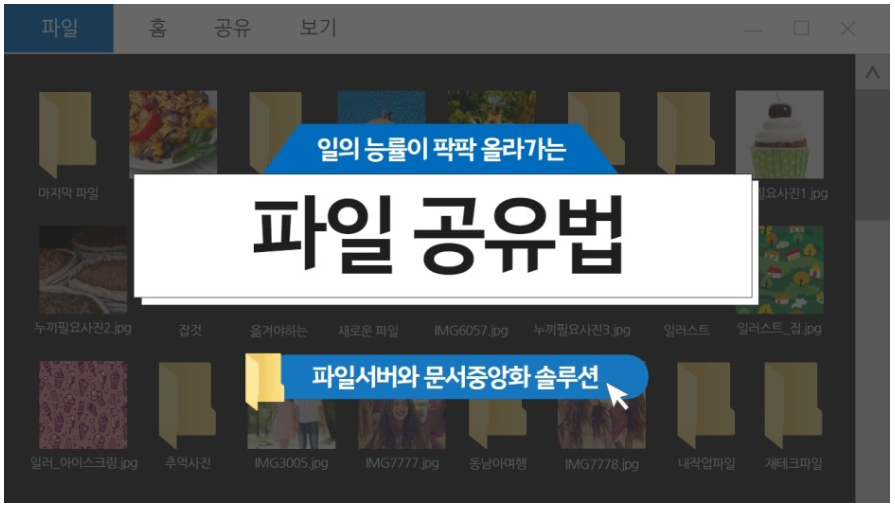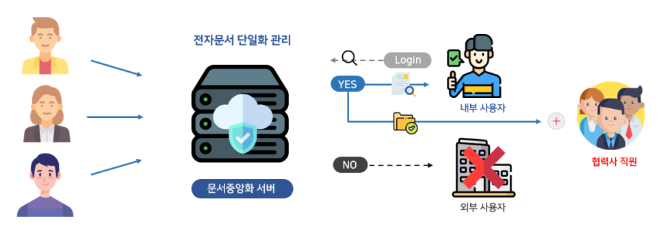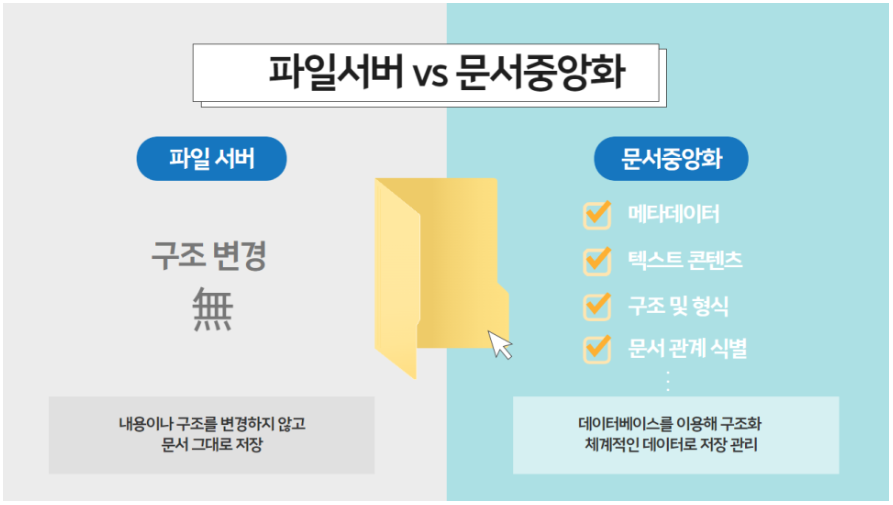오늘은 파일 서버(NAS)와 문서중앙화 솔루션에 대해 알아보고, 각 제품의 유사점과 차이점을 소개해 드리려고 합니다!
*NAS를 이용해 파일서버를 구축하시는 분들이 많아 파일서버(NAS)로 표기합니다! 둘은 조금 다른 개념!
예전에는 기업 문서관리 체계가 없거나 관리가 어려운 기업에서는 별다른 문서 관리 솔루션을 도입하지 않고 노트북이나 개인 USB에 데이터들을 저장했지만,
최근에는 모든 기업에서 생성되는 데이터의 중요성이 더더욱 높아지고 있기 때문에 기기 고장이나 분실 시 데이터 손실을 피해를 막고 데이터를 활용하기 위해
다양한 문서 관리 솔루션을 찾고 계시죠!
파일 서버를 구축하게 되면, 로컬 네트워크에 연결된 사용자는 문서를 공유하고 활용할 수 있게 됩니다.
오? 그렇다면 사이버다임 문서중앙화와 비슷하지 않나요~? 하실 수 있지만!
문서중앙화와 파일 서버(NAS)는 크나큰 차이가 있습니다!! 이 글을 끝까지 읽어주세요~
파일서버 VS 문서중앙화
파일서버(NAS)란?
파일 서버란 컴퓨터 파일을 공유하여 사용하기 위해 중앙에 파일 서버를 놓고 사용자의 접근 권한을 부여하여 관리하는 서버라고 볼 수 있습니다.
흔히 말해 윈도우에 지원하는"공유 폴더"의 확장으로 볼 수 있으며, 이 "공유 폴더"가 중앙에서 관리되고 있고 사용자 접근 권한 및 읽기/쓰기 권한
모니터링 기능이 추가된 것입니다.
파일 서버에서 가장 많이 사용하는 제품은 앞서 언급했던 NAS 서버인데요! 나스 서버는 어떤 특징을 가지고 있을까요?
NAS 서버는 휴대할 필요 없이 네트워크 연결만으로 데이터 주고받기가 가능해 부피가 크고 무거운 외장 하드에 비해 사용이 편리하다는 장점이 있습니다.
NAS는 Network Attached Storage(네트워크 결합 스토리지)의 약자로 자료를 컴퓨터에 보관하는 것이 아닌 네트워크 저장소에 보관하여 사용자들과 공유한다는
개념의 네트워크 저장 장치입니다. 중소기업에서는 시놀로지나스, 큐냅, ip TIME, 넷기어 등을 많이 사용하는 추세입니다.
문서중앙화란?
사이버다임에서 제공하는 문서중앙화 솔루션은 업무 중 생성되는 모든 문서를 개인PC가 아닌 중앙 서버에 저장하여 관리하는 솔루션입니다.
문서 유출, 유실 등을 사전에 예방할 수 있는 철저한 문서 보안 관리 솔루션으로, 내/외부자로부터 문서 보안을 유지할 뿐 아니라 랜섬웨어와 해킹 공격 등으로부터
문서를 보호하고, 인증된 암호화 기술로 안전하게 문서를 저장 관리하여 사용자는 언제 어디서는 중앙 저장소에 접속해 협업할 수 있습니다.
사이버다임 문서중앙화 제품이 시장 점유율, 구축 사례 1위^_^!!
이렇게 비교한다면, 저장 방식의 차이만 있는 것 같아 보이기도 하지만!
닮은 기능이 있을 뿐! 조금 더 살펴보면 문서중앙화의 파워풀한 기능을 확인하실 수 있습니다!
아래 설명되는 공통점과 차이점을 확인해 보면서 두 가지 솔루션에 대해 더욱 자세히 알아보겠습니다~

파일서버와 문서중앙화 솔루션의 유사점!
1. 문서 관리 - 데이터 저장을 위한 중앙 저장소 제공
2. 문서 보안 - 파일과 폴더에 접근 제어
3. 협업 및 생산성 강화 - 문서 공유로 구성원 간 협업 촉진
-----------------------------------------------------------------
1. 문서 관리 - 데이터 저장을 위한 중앙 저장소 제공
파일 서버와 문서중앙화 솔루션 모두 파일 저장이나 구성을 위한 중앙 저장소를 제공합니다! 사용자가 폴더나 하위 폴더, 파일 디렉터리를 만들어 저장할 수 있도록 구조화된 계층 구조를 제공하는데요.
파일을 중앙 저장소에 저장해 활용할 수 있기 때문에,원하는 파일을 효율적으로 검색해 활용할 수 있어 필요한 파일을 신속하게 찾을 수 있기 때문에 업무 시간이 절약되어 생산성 향상에 도움이 될 수 있습니다.
같다고 할 수 없는 문서중앙화 Point
1. 파일을 그대로 옮겨놓는 것이 아닌, 구조화된 데이터로 저장
2. 웹 화면뿐만 아니라 윈도우 탐색기와 동일한 화면 제공
3. 문서에 포함된 정보를 추출하고 효율적인 검색과 분류 가능
4. 사이버다임 문서중앙화 솔루션은 클라우드 서버에도 구축 가능, 과금형 서비스 운영 중

2. 문서 보안 - 파일과 폴더에 접근 제어
두 솔루션 모두 관리자가 파일이나 폴더에 대한 액세스 권한을 제어할 수 있습니다!
개별 사용자나 특정 그룹에 권한을 할당하는 시스템을 사용합니다. 권한은 읽기 쓰기, 수정, 삭제, 실행 등 파일과 폴더에 모두 설정할 수 있죠. 또한, 폴더에 부여된 권한을 상속해 개별 파일에 권한을 설정하지 않아도 상위 폴더에서 변경된 내용이 하위 폴더에도 모두 상속되기 때문에 접근 권한 제어 관리를 해야 하는 관리자 입장에서는 편리한 관리가 가능합니다.
같다고 할 수 없는 문서중앙화 Point
1. 사용자별, 부서별로 목록 보기/읽기/수정/삭제 등의 6단계 권한 설정으로 세부적인 접근 제어 관리
2. IP, 프로그램, 장치 접근 권한 제어 설정 가능
3. 협업 및 생산성 강화 - 문서 공유로 구성원 간 협업 촉진
문서중앙화 솔루션과 파일서버는 모두 팀원 간의 협업을 촉진합니다. 파일 공유 기능으로, 버전 제어, 편집 등 다양한 기능으로여러 사용자가 동시에 문서를 활용할 수 있어
업무 효율을 높이고 생산성을 향상시켜 줍니다.(단, 파일서버의 경우 버전 충돌, 변경사항을 수동으로 병합해야 하는 경우가 발생할 수 있죠!)
같다고 할 수 없는 문서중앙화 Point
1. 같은 문서를 열어 사용해 충돌이 일어나지 않도록, 사용 중인 문서에는 잠금 표시가 활성화됩니다.
2. 수정 중인 문서라도 읽기 전용으로 열어 문서 확인이 가능합니다.
파일 서버와 문서중앙화 솔루션의 차이점!
1. 문서 관리 - 문서 유실 없이 모든 문서를 자산화
2. 문서 보안 - 내외부 문서 보안
3. 협업 및 생산성 강화 - 언제 어디서든 원활한 업무와 협업!
---------------------------------------------------------------------
파일 서버: 파일 서버는 파일을 저장하고 네트워크의 다른 컴퓨터나 사용자가 파일에 액세스할 수 있도록 하는 컴퓨터 또는 전용 장치입니다.
파일 서버에 문서를 저장하면 내용이나 구조를 변경하지 않고 문서를 그대로 저장합니다.
예를 들어, 텍스트 파일이나 pdf문서를 파일서버에 저장하면 서버는 이를 바이너리 파일로 저장하여 추가적인 구성이나 분석 없이 원래 형식과 내용을 보존합니다.
*바이너리 파일: 바이너리 파일은 데이터의 저장과 처리를 목적으로 0과 1의 이진 형식으로 인코딩된 파일
문서 중앙화: 문서 중앙화는 문서를 중앙 집중식으로 관리하고 구성하는 프로세스를 말합니다.
문서 중앙화는 단순히 파일을 그대로 저장하는 것이 아니라 파일에 포함된 정보를 데이터베이스에 구조화된 데이터로 취급해 저장하고 체계적으로 관리합니다.
그렇기 때문에, 파일을 저장 관리 하는것 뿐만 아니라 파일 기반으로 다양한 관리 및 보안 정책을 적용하고, 협업, 활용 프로세스를 응용할 수 있어 다양한 기업의 업무 시스템과 유기적 연계가 가능합니다.
저장 방식에서 눈에 띄는 문서중앙화의 강점!
- 문서 내의 특정 정보를 이용해 키워드, 날짜 또는 작성자와 같은 특정 기준에 따라 쿼리 또는 검색으로 더 정확하고 빠른 검색을 지원합니다.
- 추출된 정보를 기반으로 태그, 레이블 또는 폴더를 생성하여 특정 기준에 따라 문서를 쉽게 그룹화 하고 분류할 수 있습니다.
- 다양한 분석 기술을 적용하여 문서 컬렉션에서 추세, 패턴 또는 상관 관계를 추출해 다양한 통찰력을 얻을 수 있습니다.
- 다른 시스템이나 프로세스와의 통합이 더 쉬워집니다. 예를 들어, 고객 관계 관리(CRM) 시스템, 프로젝트 관리 도구 또는 기타 비즈니스 애플리케이션의 관련 기록에 문서를 연결해 효율적인 업무 환경 구축이 가능합니다.

이제 아래에서 파일서버와 비교할 수 있는 상세 기능에 대해 설명 드리겠습니다~!
다양한 기능의 차이 어떤 것들이 있을까요?
1. 문서 관리 - 문서 유실 없이 모든 문서 기업의 자산으로 저장!
▶ 중앙 서버에 단일 문서 저장
문서중앙화 솔루션은 기업에서 생산되는 모든 문서를 자동으로 강제 저장함으로써 파일서버에 비해 뚜렷하게 보이는 이점이 있습니다!
사용자가 파일에 대한 변경 사항을 수동으로 저장하는 파일 서버와는 달리 문서중앙화 솔루션은 문서에 수정 사항이 발생하게 되면
중앙 서버에만 저장할 수 있고 로컬 PC나 C드라이브, USB, 외장하드 등에 저장을 막아 생성되는 모든 문서가 중앙 서버에 저장되게 합니다.
따라서, 기업에서 생산되는 업무 산출물을 모두 기업의 자산으로 저장할 수 있는 것이죠!
▶버전 기록과 복구 기능
파일서버와 다르게, 문서중앙화 솔루션은 모든 문서를 중앙에서 관리하여 데이터의 중복이나 누락 없이 모든 문서를 관리할 수 있는데요!
사이버다임의 문서중앙화 시스템은 하나의 문서의 생성부터 삭제까지 중복 문서 없이 버전으로 관리되어 모든 수정 이력을 보관합니다.
수정 사항을 자동으로 저장함으로써 예기치 못하게 발생하는 우발적인 문서 삭제나 변경, 오류에 대해 원하는 시점으로 파일 복원이 가능해 데이터 손실 위험을 최소화할 수 있습니다!
2. 내/외부 문서 보안
사이버다임의 문서중앙화 솔루션은 파일 서버에서 볼 수 없는 강력한 보안 기능을 다양하게 제공하고 있습니다.
▶ 문서 유출 경로 차단
문서중앙화 솔루션 하나로, 장치별 접근 권한 제어, 외부 저장매체 (USB, 외장하드, 웹/메일, 메신저) 등을 제어하고
인쇄, 캡처, 클립보드 등 다양한 우회 경로를 통한 문서 유출도 제어할 수 있죠!

▶ 외부 반출 승인 프로세스
중앙에 저장된 문서는 반출 승인 프로세스를 거친 후 외부로 문서 공유가 가능합니다.
승인자는 반출하려는 문서부터 누구에게 어떤 목적으로 반출되는지까지 모두 확인이 가능하기에 무분별한 문서 유출을 막을 수 있죠!
승인자는 문서 반출에 대한 요청을 받은 뒤, 승인 또는 반려가 가능하기에 목적이 불분명한 문서 반출 요청은 반려하여 중요한 문서가 외부로 유출되는 것으로부터 보호할 수 있죠.
▶ 외부 보안 공격 감염 피해 방지
관리자가 사전에 승인한 업무용 프로그램만 문서중앙화 서버에 접근할 수 있도록 하는 화이트리스트(White List) 방식으로 사전에 등록되지 않은 랜섬웨어나 악성 프로그램의 서버 접근을 차단합니다. 또한 중앙 서버에 등록된 원본 문서를 수정하는 것이 아닌, 암호화된 임시 영역에서 서버 문서를 다운로드해 작업한 뒤 문서를 서버에 저장하고, 모든 파일 경로와 파일이 암호화되어 저장되어 감염을 방지하죠.
만약 수정한 문서가 감염되더라도 해당 버전의 파일을 삭제한 뒤 이전 버전의 문서로 복구하면 해결 완료!
3. 협업 및 생산성 강화 - 언제 어디서든 원활한 업무와 협업!
▶ 언제 어디서든 중앙 서버에 접근
사이버다임 문서중앙화 솔루션은 문서에 권한이 있다면 언제 어디서든 필요한 문서에 접근해 업무할 수 있습니다.
NAS 시스템은 일반적으로 로컬 네트워크 내에서 액세스 되기 때문에 물리적인 위치가 하나인 기업에 적합한 반면에,
문서중앙화 솔루션을 이용하게 되면 인터넷 연결이 가능한 곳이라면 사무실에 있든, 원격으로 작업하든, 여행 중이든
문서가 중앙 서버에 저장되어 있기 때문에 쉽게 접근해 활용 할 수 있습니다.
▶ URL로 항상 최신 문서 공유
내부 사용자 간에는 내부 배포 URL을 사용해 파일의 위치를 공유합니다. 이렇게 공유하게 되면 수정한 파일을 다시 공유 하지 않아도
중앙에 저장된 문서가 업데이트 되기 때문에 URL을 공유받은 사람은 항상 최신의 문서를 확인 할 수 있기에 업무에서 발생할 수 있는
불필요한 작업 시간을 줄여 효율적인 업무가 가능합니다.
또한, URL 공유는 원본 문서를 공유한는 것이 아니기 때문에 문서 용량에 제한 없이 대용량 문서도 손쉬운 공유가 가능하죠.
▶ 외부 사용자와 안전하고 편리한 협업
외부 사용자에게는 외부 배포 URL을 통해 문서를 공유할 수 있습니다. 이때는 다운로드 기간/횟수 비밀번호를 제공해 보안을 강화할 수 있고,
대용량 문서도 손쉽게 전달 가능하죠. 또한 오랜 기간 협업이 필요하다면 중앙서버에 접근 가능한 임시 계정을 만들어 기간을 설정한 뒤 사용하면
권한이 있는 문서만 접근 가능한 내부 사용자와 동일하게 편리한 환경에서 업무할 수 있죠.
▶ 모바일 접근으로 원격 협업
사이버다임 문서중앙화 솔루션은 모바일 앱을 지원해 모바일 환경에서 언제 어디서든 중앙 서버에 접근해 원하는 문서를 이용할 수 있습니다.
출장이나 외근에서도 유용하게 활용할 수 있습니다.

 한국어
한국어








